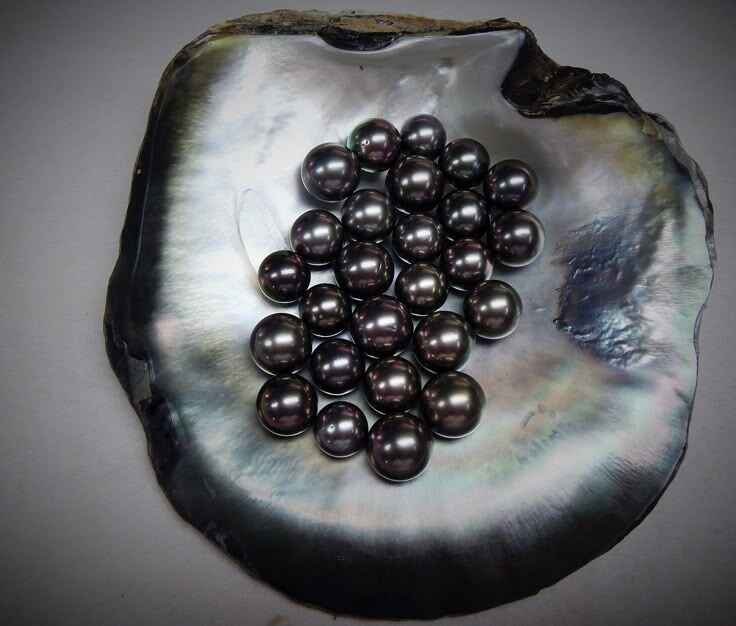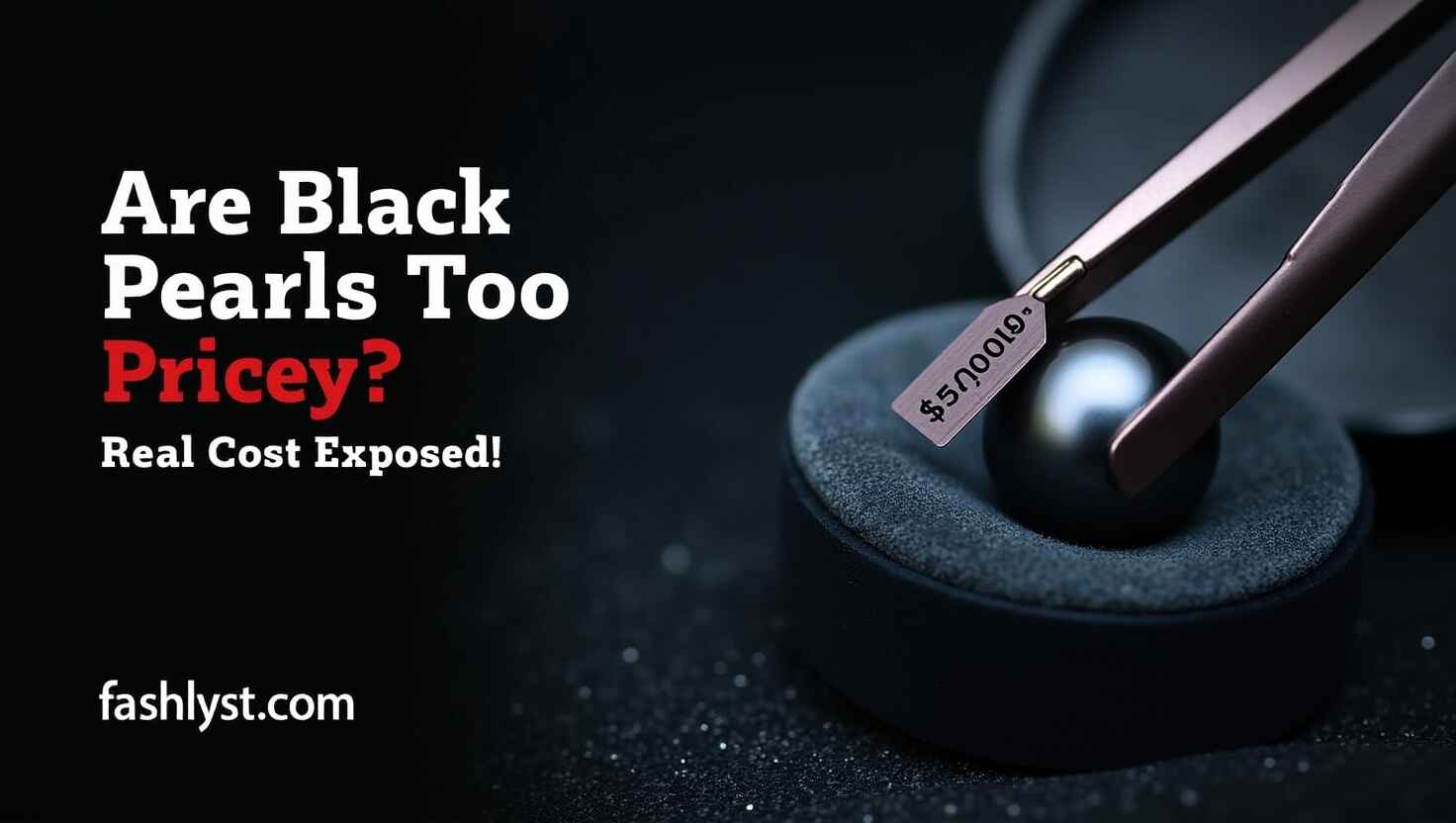The allure of black pearls goes beyond their bold look; it’s their mysterious, magical, and deeply organic beauty that makes them irresistible to collectors, jewelry lovers, and enthusiasts. Unlike many gemstones, black pearls are not mined but grown inside the black-lipped bivalve oyster, scientifically known as Pinctada Margaritifera, mostly farmed in French Polynesia, including Tahiti and its remote islands. Having seen these gems in person during a visit to Tahiti, I remember being captivated by the classy, deep dark hues and overtones of green, silver, and peacock blue. It felt like holding a piece of the ocean’s true magic.
The value and worth of these gems are shaped by many factors, such as origin, color, size, shapes, and most critically, nacre thickness. A healthy pearl requires 18 to 24 months between grafting and harvesting, allowing the nacre to build up to at least 0.8mm this directly correlates with a higher value. The rarest and most sought-after pearls can reach up to 15mm, though 8mm is more common. Whether round, semi-round, oval, baroque, teardrop, or circle shaped, their extravagant beauty lies in their wide range of shades, from gray, brown, and purple, to the beloved darker tones.
These pearls can be worth from $100 to thousands or even millions of dollars, depending on the guide used to determine their value. In my experience appraising pearls for a boutique, the answer to the question “Are they expensive?” is always: it depends. But one thing’s certain black pearls remain among the most intriguing and valuable gems in the world, with their charm never fading.
The Real Value Spectrum of Black Pearls
From my experience helping collectors choose the perfect black pearl jewelry, it’s clear the price range can vary widely. A fine strand of natural black pearls can be valued at an average of $8,000, while high-end Tahitian necklaces or sets, known for their superior quality, may even reach the five-figure range. But not all pearls are that pricey black freshwater pearls and black Akoya pearls are more accessible to budget-conscious buyers, usually costing around $50 to $2,000, making them perfect for those just entering the pearl world.

The variation in cost truly depends on whether the pearls are cultured, their size, and quality. Smaller or dyed pearls may only fetch a few hundred dollars, while large, flawless specimens can easily fetch thousands. For instance, untreated pearls of rare beauty may be priced at around $10,000 per piece. So, while some black pearls are less expensive, others command a premium especially those untouched by enhancements or treatment.
How Much Are Black Pearls Worth? Are Black Pearls Expensive?
Black pearls can be just about the same in price as white pearls if they are freshwater pearls, especially when dyed, which is most common on the market. But when you’re looking at natural Tahitian pearls, their value and worth go up significantly because of the very thick nacre that guarantees durability and makes them a good investment choice. I’ve seen how rare they are compared to others, and when they are real and untreated, black pearls become something truly special and well worth the cost.
Hidden Value in Dark Treasures
The worth of black pearls can vary significantly based on their type, origin, and quality. Their mystery and sophistication give them a special place in the jewelry market, making them highly sought after by collectors and everyday buyers alike. Unlike traditional white pearls, these dark treasures have a distinctive beauty and a unique aesthetic that adds to their appeal. From natural Tahitian pearls to dyed black freshwater pearls and dyed black Akoya pearls, each variation brings its own value depending on several factors. I’ve seen pearls with exceptional appearance and brilliant shine that were considered a fortune, even if they were smaller in size proving not all pearls are equal.
Important indicators of value include luster, shape, surface quality, nacre quality, and whether the pearl is perfectly round. A 14mm pearl with all the right boxes ticked can be worth much more than expected, while one lacking key traits may be worth less, sometimes barely a penny. In my experience, pearls that reflect the best of nature and show signs of rarity tend to be the most prized. Every factor, whether big or small, plays a crucial role in determining the final price, and that’s what makes black pearls such fascinating gems to assess and admire.
Price Difference Between Tahitian and Other Black Pearls
Tahitian black pearls, especially those cultivated in the warm waters of French Polynesia, are known for their rich dark hues and overtones of green, blue, and aubergine, making them exceptionally desirable and luxurious. A strand of natural Tahitian pearls typically command a higher price, often ranging from $300 to $10,500, with top quality gems reaching $33,500 or more, depending on luster, size, and quality. In contrast, dyed Black Freshwater Pearls may cost less, around $50 to $1000, while dyed Black Akoya Pearls fall between $150 to $2000, though still expensive depending on the method of creation and cultivation.

Compared to South Sea black pearls or another variety with similar origin, Tahitian pearls tend to be more valued due to their natural coloring and unique pricing factors, which makes collectors willing to pay more for their unmatched value.
Key Elements That Decide Pearl Value
When you want to buy a real pearl necklace, it’s smart to first assess what makes its value high or low. As someone who once helped a friend evaluate her inherited black pearls, I’ve learned that several main components must be considered to know if you’re paying a fair price. Unlike diamond valuation, which follows the 4Cs, pearls follow 7 factors that affect their worth: shape, size, colour, lustre, surface quality, nacre quality, and matching. These characteristics together show the beauty and craftsmanship behind each piece.
The Gemological Institute of America (GIA) has helped standardise grading systems for pearls, just like it has for diamonds, offering benchmarks to compare different pearl types. Each pearl, whether cultured or natural, carries unique characteristics that influence its market value, especially if there’s historical significance. A balanced, comprehensive approach is important when looking at different types of pearls this way, you’re not only choosing based on appearance but also based on quality that lasts over time.
The Hidden Power of Pearl Colour
Ever wondered why some pearls sell for thousands while others don’t? The secret often lies in their colour, a natural, yet important factor that silently affects the value of every pearl. Each shade has three hidden components: the body color (the overall, dominant tone), the overtone (a secondary, translucent layer that softly lies over the top), and the magical orient that shimmering, iridescent, rainbow glow that seems to dance across the surface, visible on the entire pearl or just a part. These layers together create a unique visual story that buyers often chase, even if they can’t explain why.
Here’s what’s really fascinating: natural and cultured pearls show a mix of pink, white, purple, blue, green, and grey, but it’s the black ones, especially Tahitian, that turn heads. Why? Because they’re incredibly rare, deeply valuable, and often carry that bold dark tone that collectors crave. I’ve seen pearls lose thousands in worth due to a smaller flaw in colour form, even whether or not the shape is perfect. Buyers look for colour that is evenly present, smooth over the surface, and glowing without any dullness. That’s what turns a simple gem into a showstopper.
What Really Affects the Price of a Pearl?
- Size matters a lot larger pearls are generally more valuable and stand out clearly in appearance.
- Luster is crucial; high-luster pearls reflect light vividly, making them highly prized in the market.
- The surface of a pearl affects its quality pearls with fewer blemishes often command higher prices.
- Shape plays a role perfectly round pearls are the most desirable, but baroque-shaped pearls also have unique appeal.
- Origin increases value; natural pearls from premium regions such as Tahitian and South Sea areas are valued more.
- Type of treatment matters: natural-colored pearls are worth more than dyed ones, which are less rare.
Why Black Pearls Are a Smart Luxury Choice
Black pearls are often seen as synonymous with elegance and exclusivity, and from my experience, their natural beauty and rarity definitely justify their price especially when sourced from reputable sellers. Among them, Tahitian pearls are celebrated for their consistent quality, making them a smart investment for anyone seeking something worthwhile. Their cost might seem high, but when you understand the high quality and the particular charm they offer, it’s clear they’re worth every bit. These pearls are not just jewelry, they carry a story of careful cultivation and unique allure, and that’s what makes them so valuable and worth the attention of serious collectors.
FAQs
How Much Can a Black Pearl Really Cost?
The price of black pearls usually depends on their size, quality, and whether they’re natural or cultured. A smaller, cultured one may cost a few hundred dollars, while large, flawless specimens can fetch thousands. The range is from $100 to $10,000 or more per pearl, showing a wide variation in value.
Quick Way to Tell if a Pearl Is Real
To check if a pearl is real, rub it against your tooth. It should feel gritty due to nacre layers. A plastic one feels smooth. Hold it up to bright light a real one will reflect in a soft, diffused manner, while fake ones have a pronounced, sharp reflection. This test will show what you have.
How Rare Are Black Pearls?
Black pearls are rare and not formed as frequently as white pearls. They are typically saltwater pearls, native to Tahiti, the largest island in French Polynesia, often called Tahiti Pearls or Tahitian Pearls, unlike common freshwater pearls.
What Makes Blue Pearls So Rare?
The rarest pearl color in the world is blue, especially when naturally formed in the sea. Though lab-grown ones are made, the striking beauty of those found in nature is extremely valuable.
Which Pearl Costs the Least?
Freshwater pearls are the cheapest, offering a wide variety. In contrast, South Sea, Tahitian, and Akoya pearls, known for their rare, perfect round shape, and outstanding beauty, are expensive and high in grade. Type and shape significantly impact price.
What Makes Black Pearls Truly Unique?
Black pearls are rare, cultured in saltwater, and originate from a distinct species, the black-lipped pearl oyster found in the South Pacific near Tahiti and the Cook Islands. Their exotic marine habitat, uniqueness, and value make them a premium, desirable jewelry collectible.
Why Are Black Pearls So Expensive?
Black-lip oysters can grow over a foot in diameter and produce black pearls that are very large, making them more valuable compared to smaller Akoya Pearls. Their sensitive nature makes the culturing process a hit or miss, which tends to increase cost and therefore makes them rare.
